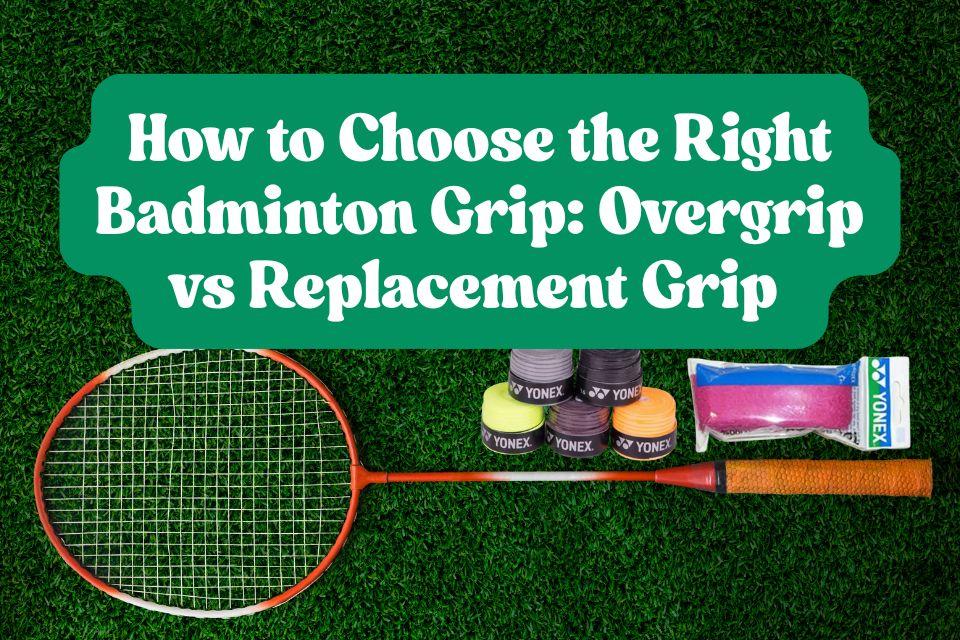


If you’ve ever felt your racket slipping mid-rally or your hand getting sore after a long match, chances are—you’re using the wrong grip. The badminton grip might seem like a small part of your gear, but it plays a huge role in comfort, control, and performance.
Whether you’re a beginner or a pro, understanding the difference between overgrips and replacement grips can help you choose what’s right for your playing style. Let’s break it down.
Why Badminton Grips Matter
The grip is the only connection between you and your racket. A good grip helps you:
Maintain control while smashing or defending.
Absorb sweat and prevent slipping.
Reduce vibrations and hand fatigue.
Customize the thickness and feel of your handle.
Pro Tip: If your shots feel inconsistent or your racket slips during play—it’s time to change your grip.
Understanding the Two Main Grip Types
Overgrip
An overgrip is a thin layer of grip tape that wraps over your existing grip (either a replacement grip or the factory base grip).
Features:
Soft and tacky for better hold.
Absorbs sweat effectively.
Easy to replace frequently.
Best For:
Players who sweat a lot.
Those who want a specific texture or tackiness.
Adding slight thickness to the handle.
Pros:
Affordable and easy to change.
Improves grip traction.
Great for short-term use.
Cons:
Wears out faster than replacement grips.
May need to be changed every few sessions for best results.
A replacement grip (also called a base grip) is a thicker grip that replaces the original handle covering.
Features:
Provides cushioning and shock absorption.
Forms the foundation for your handle.
Usually made of PU or synthetic leather.
Best For:
Players who prefer more cushioning and thicker handles.
Those who don’t replace grips frequently.
Pros:
Durable and long-lasting.
Offers comfort and vibration reduction.
Can be used alone or under an overgrip.
Cons:
Slightly more expensive.
Takes longer to replace compared to overgrips.
Popular Grip Materials and Their Uses
Material Type | Best For | Feel | Durability |
PU (Polyurethane) | General players | Soft, tacky | Moderate |
Towel Grip | Sweaty hands | Dry, absorbent | Moderate |
Synthetic Leather | Professionals | Firm, smooth | High |
Cushion Grip | Beginners | Thick, soft | Moderate |
Tip: Players who sweat more should go for towel grips or PU grips, while advanced players often prefer synthetic leather for precision.
How to Wrap a Badminton Grip Properly
Start from the bottom of the handle.
Overlap each layer slightly while wrapping upward.
Keep tension even—neither too tight nor too loose.
Secure the end with finishing tape or adhesive.
Bonus Tip: Experiment with wrapping thickness. Some players use two overgrips for a better hand fit.
When to Replace Your Grip
You should change your grip when:
It feels slippery or loses tackiness.
You notice visible wear or cracks.
Your hand starts feeling discomfort during play.
Recommended frequency:
Overgrip: Every 1–2 weeks (depending on playtime).
Replacement Grip: Every 2–3 months or sooner if heavily used.
Expert Recommendation
For most players, the best setup is a replacement grip + overgrip combination.
The replacement grip provides comfort and shock absorption.
The overgrip ensures traction and sweat absorption.
Example: Start with a Yonex PU replacement grip and add a Yonex Super Grap or Li-Ning GP20 overgrip for the perfect balance.
A badminton grip may seem minor, but it’s a game-changer for performance. Choose your grip type based on comfort, sweat levels, and playing frequency.
If you’re unsure where to start, try both replacement and overgrips to find your ideal combination.
And remember—your best shots come when you’re comfortable holding your racket. Explore top-quality Yonex, Li-Ning, and Victor badminton grips online at SportsGear24x7 and level up your grip game today!
Q1. How often should I replace my badminton grip?
Overgrips should be replaced every 1–2 weeks, while replacement grips can last up to 3 months depending on usage.
Q2. Which grip is best for sweaty hands?
Towel grips or PU overgrips are ideal as they absorb sweat and prevent slipping during long rallies.
Q3. Can I use both an overgrip and a replacement grip together?
Yes! This is the preferred setup for most players—comfort from the replacement grip and tackiness from the overgrip.
Q4. What’s the difference between Yonex and Li-Ning grips?
Yonex grips (like Super Grap) are known for tackiness and durability, while Li-Ning grips (like GP20) offer a softer feel and sweat absorption.
Q5. How do I clean my grip?
Wipe it with a dry or slightly damp cloth after each session. Avoid soaking—it can damage the material.